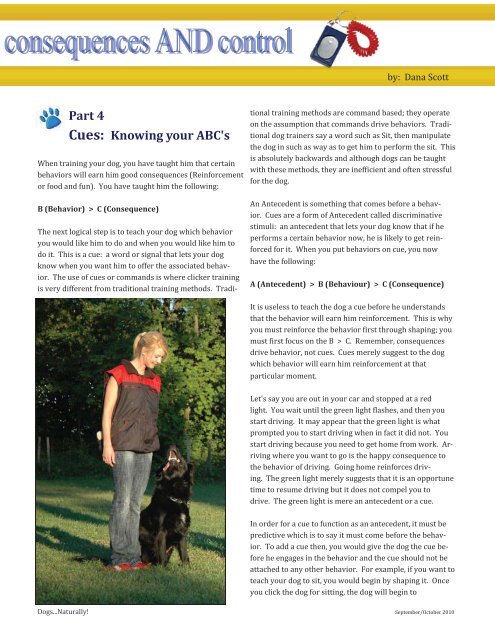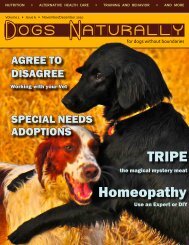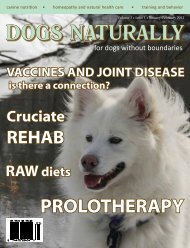y: Dana ScottPart 4Cues: Knowing your ABC'sWhen training your dog, you have taught him that certainbehaviors will earn him good consequences (Reinforcementor food and fun). You have taught him the following:The next logical step is to teach your dog which behavioryou would like him to do and when you would like him todo it. This is a cue: a word or signal that lets your dogknow when you want him to offer the associated behavior.The use of cues or commands is where clicker trainingis very different from traditional training methods. Traditionaltraining methods are command based; they operateon the assumption that commands drive behaviors. Traditionaldog trainers say a word such as Sit, then manipulatethe dog in such as way as to get him to perform the sit. Thisis absolutely backwards and although dogs can be taughtwith these methods, they are inefficient and often stressfulfor the dog.B (Behavior) > C (Consequence)An Antecedent is something that comes before a behavior.Cues are a form of Antecedent called discriminativestimuli: an antecedent that lets your dog know that if heperforms a certain behavior now, he is likely to get reinforcedfor it. When you put behaviors on cue, you nowhave the following:A (Antecedent) > B (Behaviour) > C (Consequence)It is useless to teach the dog a cue before he understandsthat the behavior will earn him reinforcement. This is whyyou must reinforce the behavior first through shaping; youmust first focus on the B > C. Remember, consequencesdrive behavior, not cues. Cues merely suggest to the dogwhich behavior will earn him reinforcement at thatparticular moment.Let's say you are out in your car and stopped at a redlight. You wait until the green light flashes, and then youstart driving. It may appear that the green light is whatprompted you to start driving when in fact it did not. Youstart driving because you need to get home from work. Arrivingwhere you want to go is the happy consequence tothe behavior of driving. Going home reinforces driving.The green light merely suggests that it is an opportunetime to resume driving but it does not compel you todrive. The green light is mere an antecedent or a cue.In order for a cue to function as an antecedent, it must bepredictive which is to say it must come before the behavior.To add a cue then, you would give the dog the cue beforehe engages in the behavior and the cue should not beattached to any other behavior. For example, if you want toteach your dog to sit, you would begin by shaping it. Onceyou click the dog for sitting, the dog will begin to<strong>Dogs</strong>...<strong>Naturally</strong>! <strong>September</strong>/October 2010
offer you sits. He must be offering sits in a predictable mannerso that you can add the cue just a moment before hesits. If you say Sit while he is already sitting, the cue will notwork because it will not be an antecedent. It must come beforethe behavior to be effective. On the other hand, if yousay Sit and your dog is not ready to sit, he will not learn thecue because the cue will again not predict the behavior.In order to add cues, your dog must first be proficient at thedesired behavior. If you want to put Sit on cue, your dogshould be offering sit regularly and predictably. If your dogis offering you a sit every two to five seconds, you can easilyadd the cue and know that the dog will offer the behaviorafter the cue. Putting sit on cue will look a little like this:You cue the dog to Sit (antecedent) > Dog sits(behavior) > Dog gets cookie (consequence)Now that you understand how to add cues, you just need afew more details to develop skill with the clicker.You must be careful when adding cues that you are actuallygetting the behavior you want. If you want your dog to sitstraight up and not flopped over on one hip, do not add thesit cue until your dog is sitting straight with predictability. Ifyou add the Sit cue and your dog flops over onto his hip, youare attaching the Sit cue to the wrong behavior. When itcomes to cues, the quality goes in before the name goes on!Now here is the best part about clicker training. Cues willbecome rewarding for your dog. He will love it when you askhim to do something for you. If you are skeptical of this, youjust need to learn a bit more about the sciencebehind behavior.You might remember Ivan Pavlov from highschool or college. Ivan Pavlov was a physiologistdoing research on digestive functionand he used dogs as a part of his experiment.He would feed the dogs a meat pasteand measure the amount of saliva and digestivejuices produced by the dogs in response.He started to run into difficultyhowever, when the dogs started salivatingbefore he was ready to measure them. Asthe dogs gained experience, they quicklylearned that white coats proceeded meatpowder and they would begin salivating assoon as somebody entered the room.Despite earning a Nobel prize for his work in physiology anddigestion, Pavlov was fascinated by this response. Hechanged gears completely and began the experiments thatmost people are familiar with today. He would ring a bellbefore feeding the dog and the dog would soon salivate everytime they heard the bell, whether food was present or not.Pavlov called this Classical Conditioning or relational learning.The dogs learned that because the bell preceded food,the bell was a predictor of food. Since food was a stimulusfor salivating, the bell that predicted food become a'conditioned' stimulus and the dog reacted to the bell thesame way he did food.Within the context of Classical Conditioning, cues becomepredictors of food. This is why it is important to train thebehavior before adding cues: when we add the cue, fullyknowing that the dog will comply, he will get a reward inresponse. In this way, cues such as Come or Sit are conditionedstimuli and our dogs look at them as money in thebank! Your cues will trigger an emotional response in yourdog that will motivate him to want to comply.Now that you understand how to add cues, you just need afew more details on develop skill with the clicker. We willtake a look at this in the next issue The owner of WatchMe! dog training, Dana Scott has a degreein animal behavior and has titled her dogs in obedience, rally,conformation and in the field. Dana breeds Labrador Retrieversunder the Fallriver prefix. She can be reached atwww.fallriverlabs.comwww.dogsnaturallymagazine.com <strong>September</strong>/October 2010 | 31












